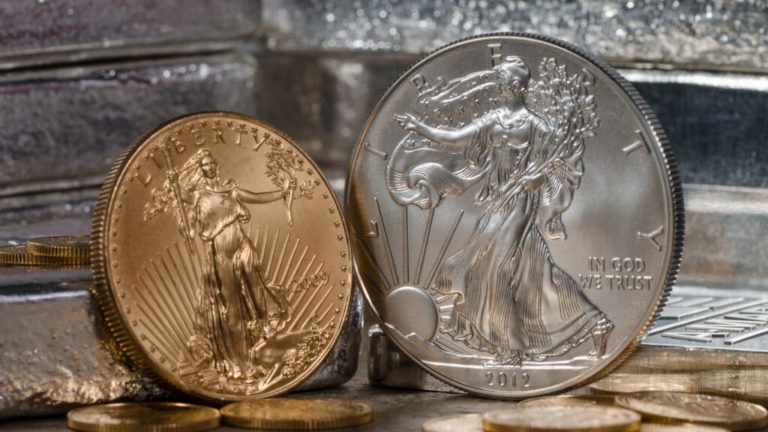The Gold-to-Silver Ration: What Does it Mean?

So, you’ve heard the phrase: The Gold To Silver Ratio, or, the reverse, The Silver To Gold Ratio. What does it mean? Why is it important? I’ll try to explain.
In the simplest terms, it means how many ounces of silver does it takes to purchase one ounce
of gold. As both precious metals increase or decrease in daily value, so does the ratio. I’ll
explain. Currently, an ounce of gold trades for $1,908 and an ounce of silver is trading for
$23.50. Divide the gold price of $1,908 by the silver price of $23.50 and your result is 81.21.
This is the Gold To Silver ratio. It will take 81.21 ounces of silver to purchase one ounce of gold.
Basically a 81 to 1 ratio.
Now, how do you interpret the information? Is this a good or bad ratio? Should I buy or sell my
silver? Should I buy or sell my gold? These are all questions you’ll want to answer, but how?
This ratio formula is nothing new. It has been used for centuries by governments, dating back
to the Roman Empire. Below is a nice comparison through the centuries.
- 2022: In 2021-2022, the ratio has fluctuated greatly, ranging between around 65
and 95. - 2020: For the year, the gold-silver ratio peaked at 114.77, the highest it’s ever
been since 1915. - 1991: When silver hit record lows, the ratio peaked at nearly 100.
- 1980: At the time of the last great surge in gold and silver, the ratio stood at
about 15. - 1834-1862: Congress moved to change the ratio to 16 from 15.
- 1792-1834: The U.S. operated a bimetallic standard, with a fixed ratio of 15.
- Roman Empire: The ratio was set at 12:1
Congressional Research Service. “Brief History of the Gold Standard in the United States,” Pages 2-3 and 9.
So why is this ratio important for investors or traders? If they can anticipate which way the
ratio is going, they can make a profit even if the price of the two metals falls or rises.
The theory of the Gold To Silver Ratio is to trade the precious metals for each other when the
ratio swings largely in one direction or the other. For example:
1. When a trader possesses one ounce of gold and the ratio rises to an unprecedented
100 to 1, the trader would sell their single gold ounce for 100 ounces of silver.
2. If the ratio then contracted to an opposite historical extreme of 50 to 1, for example,
the trader would then sell their 100 ounces of silver for two ounces of gold.
3. By doing either of the above, the trader will continue to accumulate quantities of the
precious metals, seeking wild swings in the ratios to trade and maximize holdings.
Keep in mind that no U.S. dollar amount was factored in to this ratio when deciding to trade
one precious metal for another. It is merely the value (or ratio) between the two metals.
When the ratio increased to 100 to 1, the investor sold one ounce of gold for 100 ounces of
silver and physically stored the metals. When the ratio dipped to 50 to 1, the investor traded
his 100 ounces of silver for two ounces of gold, thus doubling his gold holding.
There are a few ways to use the Gold To Silver Ratio to trade silver and gold. I, personally,
suggest trading the actual physical metals and storing them yourself. This way you take actual
possession of the metals and you own them outright. Security of these metals, of course,
should be a serious concern. Store them in a safe deposit box, a quality-rated safe in your
home or some other secure location you trust. The other two ways are trading in silver or gold
future contracts and ETF, Exchange Traded Funds. Future Contracts is merely buying paper
stating that you own so many ounces of either precious metals. ETFs allow you to trade in one
metal or the other through the exchange fund. When the ratio rises, you buy silver. When it
falls, you buy gold. This way you’re not committed to timing the ratio for the best return.
In conclusion understanding the Gold To Silver Ratio is goal number one. Once you
understand the meaning, it will be up to you, according to your risk tolerance and appetite, to
decide when to act on the ratio. Don’t look at the “short-term” swings. Look at longer term
time frames. I suggest visiting www.kitco.com, click on “markets” and click on “Gold Ratios.”
From here, review the 24 hour, 30 & 60 day trends, 1 year & 5 year data. You’ll get a picture
of the past and future trends. Hopefully, this will help you decide your precious metals
investment strategy.
For further information, please email me at decaturjewelry2@comcast.net

